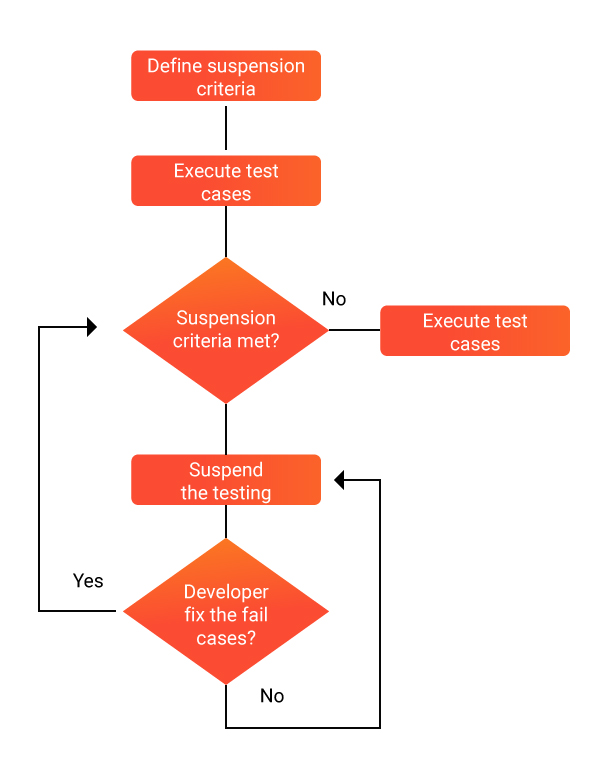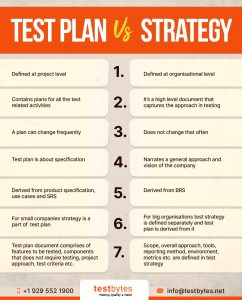
How To Create a Test Plan? Step-By-Step Tutorial
January 6th, 2024

Test plans define a structured process under the control of test managers, serving as roadmaps for software testing. Team members with in-depth system knowledge create these blueprints, ensuring that each test case is functional and going through a thorough review by senior experts.
Importance of test plans
- Risk Identification: Test plans aid in identifying potential risks associated with the software, allowing preemptive mitigation strategies.
- Resource Planning: They assist in planning resources, including human resources, tools, and infrastructure required for testing activities.
- Scope Definition: Test plans clearly outline the scope of testing, ensuring that all functionalities and scenarios are covered.
- Quality Assurance Guidelines: Establishing quality assurance guidelines ensures adherence to standards, promoting consistency across testing phases.
- Communication Tool: The document serves as a communication tool, fostering understanding among developers, testers, and business managers.
- Traceability Matrix: Test plans often include a traceability matrix, linking test cases to requirements and enabling comprehensive test coverage.
- Estimation and Budgeting: Test plans facilitate accurate estimation of testing efforts, aiding in budgeting and resource allocation.
- Continuous Improvement: Post-implementation test plans contribute to continuous improvement by capturing lessons learned and refining future testing processes.
What Are The Objectives Of The Test Plan?
- Quality Assurance: Define a roadmap for thorough testing, ensuring software functions as intended and meets user needs.
- Identify Risks & Issues: Proactively anticipate potential problems like bugs or performance bottlenecks before they impact users.
- Scope & Efficiency: Establish clear testing boundaries and prioritize tasks, avoiding wasted time and ensuring resource allocation.
- Communication & Collaboration: Set expectations for testing activities, roles, and responsibilities, promoting teamwork and transparency.
- Measurable Improvement: Define success metrics (e.g., bug coverage, defect rate) to track progress and assess test effectiveness.
Remember, a good test plan is a living document – updated as needed to adapt to changing circumstances and ensure smooth software development.
Step-by-step Process of Creating An Effective Test Plan
-
-
- Step #1. Product Analysis
- Step #2. Designing test strategy
- Step #3. Identifying the Testing Type
- Step #4. Interpret test objectives
- Step #5. Outline test criteria
- Step #6. Planning Resources
- Step #7. Define test Environment
- Step #8. Create Test Logistics
- Step #9. Document Risk & Issues
- Step #10. Outline Test Criteria
- Step #11. Estimation and Scheduling
-
Let’s dive into the step-by-step tutorial of How To Create a Test Plan
Step #1. Product Analysis
Requirements Analysis:
-
- Initiate the test plan creation process by conducting a comprehensive analysis of software requirements. This forms the foundation for subsequent testing phases.
System Analysis:
-
- Prioritize thorough system analysis to gain a holistic understanding of the software’s architecture, functionalities, and interactions.
Website and Documentation Review:
-
- Scrutinize the website and product documentation to extract detailed insights into software features, configurations, and operational procedures.
Stakeholder Interviews:
-
- Engage in interviews with key stakeholders, including owners, end-users, and developers, to garner diverse perspectives and nuanced insights into the software.
Client Research:
-
- Conduct in-depth research on the client, end-users, and their specific needs and expectations. Understand the client’s business objectives and how the software aligns with those goals.
Key Questions for Analysis:
-
- Pose critical questions to guide the analysis process:
- What is the intended purpose of the system?
- How will the system be utilized?
- Who are the end-users, and how will they interact with the system?
- What are the development requirements for implementing the system effectively?
- Pose critical questions to guide the analysis process:
Clarification Interviews:
-
-
-
- If any aspect of the system’s requirements remains unclear, conduct interviews with clients and relevant team members for detailed clarification.
-
-

Step #2. Designing test strategy
Definitely, the scope of the testing is very important. To put it in simple words, know what you need to test and what you don’t need to test. All the components that need to be tested can be put under “in scope,” and the rest can be defined as “out of scope.”.
It helps
- To give precise information on the testing being done
- Also, it helps testers to know exactly what they need to test.
But the main question that arises here is how you would know what needs to be “in scope” and what needs to be “out of scope.”
There are a few points that you need to keep in mind while defining the scope of the test
- Look into what exactly customer requirements are
- What is the budget of your project?
- Focus nicely on Product Specification
- You should also take into account your team members’ skills and talents.
Step #3. Identifying the Testing Type: which testing should happen
Now that we’ve established a thorough understanding of what needs to be tested and what doesn’t, the next crucial step is defining the types of testing required. Given the diverse array of testing methodologies available for any software product, it’s essential to precisely identify the testing types relevant to our software under test.
Prioritization becomes key, allowing us to focus on the most pertinent testing methodologies. This ensures that our testing efforts align with the specific needs and intricacies of the software, optimizing the overall quality assurance process.
You can consider the budget of the project, the time limitations, and your expertise to prioritize the testing type.
Step #4. Interpret test objectives
Defining precise test objectives is paramount for effective test execution, ensuring a systematic approach to identifying and resolving software bugs. The ultimate goal is to ascertain that the software is devoid of defects. The process of interpreting and documenting test objectives involves two critical steps:
- Feature and Functionality Enumeration:
- Compile an exhaustive list of all system features, functionalities, performance criteria, and user interface elements. This comprehensive catalog serves as the foundation for targeted test scenarios.
- Target Identification:
- Based on the listed features, establish the desired end result or target. This involves defining the expected outcomes, performance benchmarks, and user interface standards that signify successful software operation.
Step #5. Outline test criteria
The test criteria are a rule or a standard on which the test procedure is based. 2 types of test criteria need to be resolved:
1. Suspension Criteria: Here, you specify the critical suspension criteria for a test. When the suspension criteria are met, the active test cycle is suspended.
2. Exit Criteria: Exit criteria specify the successful completion of a test phase.
Exit Criteria

For example, if 95% of all the tests pass, you can consider the test phase to be complete.
The run rate and pass rate are two prominent ways to define exit criteria
Run rate = the number of test cases executed/total test cases of the test specification.
Pass rate = numbers of test cases passed / test cases executed.
These are retrieved from test metrics documents.
The major Run rate has to be 100%. The exception can be considered if a clear and eligible reason is mentioned for a lower run rate.
The pass rate can be variable depending on the project scope. But certainly, a higher pass rate is always a desirable goal.
Step #6. Planning Resources
Resource planning, as the name implies, involves crafting a comprehensive overview of all essential resources essential for project execution. This encompasses a spectrum of elements, including human resources, hardware, software, and other necessary materials.
The significance of resource planning lies in its ability to detail the requirements crucial for the project’s success.
By explicitly specifying the required resources, the test manager can formulate precise schedules and accurate estimations, facilitating the seamless and effective execution of the project. This process ensures optimal utilization of resources, contributing to the overall success of the testing project.
| No. | Member | Tasks |
|---|---|---|
| 1 | Test Manager | Manages the entire project.
Directs the team. Hires require efficient resources. |
| 2 | Tester | Identifies test techniques, tools, and automation architecture.
Creates comprehensive test plans. Executes tests, logs results, and reports defects. |
| 3 | Developer in Test | Executes test cases, test suites, and related activities. |
| 4 | Test Administrator | creates and manages the test environment and its assets.
Assists testers in effectively utilizing the test environment. |
Some of the system resources you should look for are
- Server
- Test tool
- Network
- Computer
Step #7. Define test Environment
The test environment is a critical element, encompassing both hardware and software, where the test team executes test cases. It constitutes a real-time instance that mirrors the actual user experience, incorporating the physical environment, including servers and front-end interfaces. To comprehensively define the test environment:
- Hardware Configuration:
- Specify the hardware components required for testing, detailing server specifications, network configurations, and end-user devices.
- Software Configuration:
- Outline the software components crucial for testing, including operating systems, databases, browsers, and any specialized testing tools.
- User Environment:
- Consider the end-user experience by replicating the conditions they will encounter during actual system usage.
- Server Setup:
- Detail the server architecture, configurations, and any specific settings essential for testing server-side functionalities.
- Front-End Interface:
- Define the front-end interfaces, detailing the user interfaces, GUI elements, and any specific design considerations.
- Data Configuration:
- Specify the test data required for executing test cases, ensuring it accurately represents real-world scenarios.
- Dependencies:
- Identify any external dependencies, such as APIs, third-party integrations, or external services, is crucial for testing.
- Test Environment Documentation:
- Create comprehensive documentation detailing the entire test environment setup, configurations, and any unique considerations.
Step #8. Create Test Logistics
Creating effective test logistics involves addressing two crucial aspects:
1. Who Will Test?
- Skill Analysis: Conduct a thorough analysis of team members’ capabilities and skills. Understand their strengths, expertise, and proficiency in specific testing types or tools.
- Task Assignment: Based on the skill set, assign appropriate testing tasks to team members. Ensure that each tester is aligned with testing activities that match their expertise.
- Responsibility Allocation: Clearly define roles and responsibilities within the testing team. Specify who is responsible for test case creation, execution, result analysis, and defect reporting.
- Cross-Training: Consider cross-training team members to enhance flexibility. This ensures that multiple team members can handle critical testing tasks, reducing dependencies.
2. When Will the Test Occur?
- Timelines: Establish strict timelines for testing activities to prevent delays. Define specific start and end dates for each testing phase, considering dependencies and overall project timelines.
- Test Scheduling: Develop a comprehensive test schedule that outlines when each testing activity will take place. This includes unit testing, integration testing, system testing, and any other relevant testing phases.
- Parallel Testing: If applicable, plan for parallel testing to expedite the overall testing process. This involves conducting multiple testing activities simultaneously.
- Continuous Monitoring: Implement a continuous monitoring mechanism to track progress against timelines. This helps identify potential delays early on and allows for timely corrective actions.
- Coordination: Foster clear communication and coordination among team members to ensure everyone is aware of the testing schedule and any adjustments made.
Step #9. Document Risk & Issues
| Risk | Potential Issues | Mitigation Strategy |
|---|---|---|
| Skill Lack in Team Members | Inefficient testing, missed bugs, project delays | – Arrange training workshops or boot camps.
– Mentor junior team members by senior members. – Hire experienced professionals to fill skill gaps. |
| Short Deadlines, Lack of Rest Periods | Reduced testing quality, burnout, compromised health | – Prioritize critical test cases and optimize the testing flow.
– Negotiate realistic deadlines and adjust the project scope if needed. – Schedule regular breaks and encourage team members to take leave. |
| Lack of Management Skills | Unclear roles, poor communication, demotivated team | – Implement leadership training programs.
– Delegate tasks and empower team members to take ownership. – Establish clear communication channels and promote collaboration. |
| Lack of Collaboration Among Team Members | Silos, knowledge gaps, inefficient teamwork | – Encourage team-building activities and social events.
– Implement cross-functional collaboration initiatives. – Create a culture of knowledge sharing and open communication. |
| Budget Overruns | Financial constraints, project delays, resource limitations | – Clearly define the test scope and focus on high-impact areas.
– Implement cost-effective testing tools and methodologies. – Monitor expenses closely and adjust resource allocation as needed. |
Step #10. Outline Test Criteria
“Suspension criteria” refers to predefined conditions or thresholds that, when met, trigger the temporary halt or suspension of a testing phase until specific issues are addressed. In the context you provided, the suspension criteria is set at a failure rate of 40% for test cases. Let’s elaborate on this:
Suspension Criteria Explanation:
In your testing process, you’ve established a key metric to evaluate the health and readiness of the software being developed. This metric is the percentage of failed test cases. When this metric reaches or exceeds 40%, it serves as a trigger for the suspension of testing activities. This implies that if a sizable portion of the test cases are failing, the testing phase will temporarily stop until the development team addresses the identified issues.
Purpose of Suspension:
The need to make sure that the software is of sufficient quality before continuing testing is what drives the decision to suspend testing at a 40% failure rate. A high failure rate indicates potential critical issues or bugs that, if left unaddressed, could lead to a suboptimal product or system.
Workflow after Suspension:
Once the suspension criteria are met, the testing team communicates the situation to the development team. The development team then focuses on fixing the identified issues, whether they are coding errors, logic flaws, or other bugs causing the test failures. Once the fixes are implemented, the testing team resumes their activities to verify that the issues have been adequately addressed.
Benefits of Suspension Criteria:
- Quality Assurance: It ensures that only software meeting a certain quality standard progresses through the testing phases.
- Efficiency: By pausing testing during a high failure rate, it prevents the identification of additional issues that might arise due to the existing, unresolved problems.
- Collaboration: Encourages collaboration between testing and development teams to resolve identified issues promptly.
- Resource Optimization: Prevents the allocation of resources for testing on software that is likely to have significant issues.

Step #11. Estimation and Scheduling
Estimation and Scheduling in the Test Environment Phase:
In the test environment phase, the test manager plays a crucial role in estimating the resources, time, and effort required for testing activities. Estimation involves predicting the testing effort, duration, and resources needed to complete the testing process successfully. The test manager uses various techniques and relies on key inputs to arrive at a realistic estimate. Additionally, the estimation is closely tied to the overall project schedule.
Key Inputs for Estimation in a Test Environment:
- Project Deadline: The overall deadline for the project is a critical input. It sets the time boundary within which testing activities must be completed to ensure timely delivery.
- Project Estimation: The estimated effort and schedule for the entire project, as determined during the project planning phase, provide a baseline for the testing phase. The test manager considers the overall project timeline and allocates a proportionate timeframe for testing.
- Project Risk: Understanding the project risks is essential for accurate estimation. Risks such as unclear requirements, frequent changes, or complex functionalities can impact testing effort and duration.
- Employee Availability: The availability of team members and their skill levels directly affect the estimation. The test manager considers the capacity of the testing team and ensures that resources are available when needed.
Estimation Techniques:
- Bottom-Up Estimation: Breaking down the testing activities into smaller tasks and estimating each task individually. This detailed approach provides a more accurate estimation but requires a thorough understanding of the testing requirements.
- Expert Judgment: Relying on the expertise of experienced team members or industry experts to provide insights into the effort required for testing activities.
- Analogous Estimation: Drawing on past projects with similar characteristics to estimate the effort and time required for the current testing phase.
Binding Estimation to Test Planning Schedule:
Once the estimation is complete, the test manager aligns it with the overall project schedule and creates a detailed test plan. The test plan outlines the testing strategy, scope, resources, schedule, and deliverables. It includes milestones, timelines for different testing activities, and dependencies on development milestones.
Benefits of Binding Estimation to Schedule:
- Alignment with Project Goals: Ensures that testing activities are synchronized with the overall project timeline and objectives.
- Resource Planning: Helps in allocating resources effectively, avoiding bottlenecks, and ensuring that team members are available when needed.
- Risk Mitigation: Identifies potential scheduling risks and allows the test manager to plan for contingencies or adjustments as needed.
- Communication: Clearly communicates the testing schedule to all stakeholders, fostering transparency and accountability.
By binding estimation to the schedule, the test manager enhances the likelihood of meeting project deadlines while maintaining the quality and thoroughness of the testing process. This integrated approach contributes to successful project delivery.
Step #12. Govern test deliverables
Governance of test deliverables is a critical aspect of the testing process, ensuring that all documents, components, and tools developed to support testing efforts are managed, monitored, and delivered effectively. This involves establishing processes, controls, and guidelines to ensure the quality, accuracy, and timeliness of the deliverables. Here’s how the governance of test deliverables can be approached:
- Define Clear Standards:
- Establish clear and standardized templates for test deliverables. This ensures consistency across different testing phases and projects.
- Define standards for document structure, content, and formatting to enhance readability and understanding.
- Document Version Control:
- Implement a robust version control system to track changes and updates to test deliverables. This ensures that stakeholders are always working with the latest and approved versions.
- Clearly label and document version numbers, revision dates, and changes made in each version.
- Traceability:
- Ensure that there is traceability between test deliverables and project requirements. This helps in validating that all testing activities align with the defined requirements.
- Maintain traceability matrices to track the relationship between requirements, test cases, and other deliverables.
- Review and Approval Process:
- Institute a formal review process for all test deliverables. This involves involving relevant stakeholders, including developers, business analysts, and project managers.
- Obtain necessary approvals before progressing to the next phase or releasing deliverables to other teams or clients.
- Delivery at Specified Intervals:
- Plan and communicate the delivery schedule for test deliverables at specified intervals, aligning with the overall development timeline.
- Ensure that stakeholders, including development teams and project managers, are aware of the delivery milestones and can plan their activities accordingly.
- Comprehensive Test Deliverables:
- Test deliverables should cover all relevant aspects of testing, including but not limited to:
- Test plans outlining the testing strategy, scope, resources, and schedule.
- Design specifications detailing test cases, scenarios, and data.
- Simulators or test environment setup documents.
- Error and execution logs for tracking issues and test execution results.
- Installation and test procedures for deploying and conducting tests.
- Test deliverables should cover all relevant aspects of testing, including but not limited to:
- Documentation Maintenance:
- Establish procedures for ongoing maintenance of test documentation. This includes updating documents based on changes in requirements, test cases, or any other relevant information.
- Auditing and Compliance:
- Conduct periodic audits to ensure compliance with established standards and processes.
- Address any non-compliance issues promptly and make necessary improvements to the documentation processes.
Difference Between Test Plan And Test Strategy

Test Plan Example
Conclusion
While the steps outlined above serve as a comprehensive guide for creating a test plan, it’s crucial to recognize that the approach may vary based on the unique requirements and scope of each project.
Your company should establish its own set of guidelines and procedures tailored to the specific needs of the organization. Now, take a moment to breathe a sigh of relief and dive confidently into your testing work.
With a well-crafted test plan and a clear roadmap, you’re equipped to navigate the challenges and contribute to the success of your project. Best of luck!


 Software Testing Events
Software Testing Events App Testing
App Testing Web App Testing
Web App Testing Game Testing
Game Testing Automation Testing
Automation Testing Load Testing
Load Testing Security Testing
Security Testing Performance Testing
Performance Testing Hire a Tester
Hire a Tester






